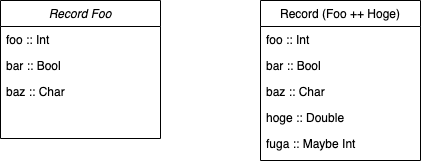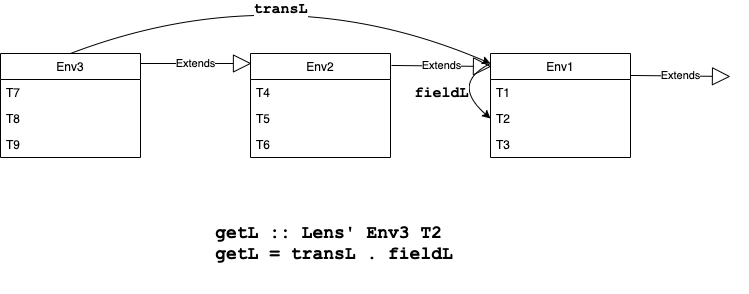はじめに
Haskellにおける拡張可能レコードは extensible が有名ですが、
今回新たな拡張可能レコードライブラリを作ったので紹介します。
Row polymorphism
Row polymorphismとは特定のフィールドを持ったレコード型ならなんでも渡せるような関数を書く方法です。
例えばPureScriptでは以下のようなInt型のフィールドfooを持つ任意のレコードを渡せる関数fを定義することができます。
f :: forall r. { foo :: Int | r } -> Int
f x = x.foo + 1
>>> f { foo : 10, bar : True }
11
>>> f { foo : 3 }
4
Haskellでもextensibleを使うとRow polymorphismを再現できます。
import Data.Extensible
import Control.Lens
f :: Lookup xs "foo" Int => Record xs -> Int
f = x ^. #foo + 1
>>> f ( #foo @= 11 <: #bar @= True <: nil )
11
>>> f ( #foo @= 3 <: nil )
4
レコードの拡張と部分適用
さて、あるレコードに対して、特定のフィールドを追加したい場合はどのようにしたら良いでしょうか?
extensibleでは(<:)演算子を使ってレコードを拡張できます。
extendBar :: Record xs -> Record ("bar" :> Bool ': xs)
extendBar x = #bar @= True <: x
この演算子をつかってフィールドの部分適用はできるでしょうか?
ここでいう部分適用とは必要なフィールドのうち一部分だけを渡すことです。
例えば、fooフィールドとbarフィールドが必要なレコードを引数にとる関数fのうち、
barフィールドだけ部分適用したapplyBarFを定義することです。
f :: (Lookup xs "foo" Int, Lookup xs "bar" Bool) => Record xs -> Int
f = ...
applyBarF :: Lookup xs "foo" Int => Record xs -> Int
applyBarF = ???
直感的には以下のように書けそうです。
applyBarF :: Lookup xs "foo" Int => Record xs -> Int
applyBarF x = f (#bar @= True <: x)
しかし残念ながら型エラーが発生します。(もしこの型エラーの直し方をご存知の方がいたら教えていただけると嬉しいです)
Extensible.hs:18:15: error:
• Couldn't match type ‘Type.Membership.Internal.Elaborate
"bar"
((0 ':> Bool) : Type.Membership.Internal.FindAssoc 1 "bar" xs)’
with ‘'Type.Membership.Internal.Expecting (n0 ':> Bool)’
arising from a use of ‘f’
The type variable ‘n0’ is ambiguous
• In the expression: f (#bar @= True <: x)
In an equation for ‘applyBarF’: applyBarF x = f (#bar @= True <: x)
• Relevant bindings include
x :: Record xs (bound at tmp/Extensible.hs:18:11)
applyBarF :: Record xs -> Int (bound at tmp/Extensible.hs:18:1)
|
18 | applyBarF x = f (#bar @= True <: x)
以下のようにfooフィールドを取り出してきて別のレコードを作れば動きますが、いちいち
フィールドを取り出すのは面倒でしょう。
applyBarF :: Lookup xs "foo" Int => Record xs -> Int
applyBarF x = f (#bar @= True <: #foo @= (x ^. #foo) <: nil)
ちなみにPureScriptなら部分適用ができます。
import Prim.Row
import Record
import Type.Proxy
f :: forall r. { foo:: Int, bar :: Boolean | r} -> Int
f x = ...
applyBarF :: forall r. Lacks "bar" r => { foo :: Int | r } -> Int
applyBarF x = f (insert (Proxy :: Proxy "bar") true x)
レコード拡張のコスト
さて、フィールド数$n$のレコードを$d$個のフィールドで拡張するときに発生する計算コストはどれだけでしょうか?
- extensibleではレコードは配列として実装されています。配列の拡張を行うので$\mathcal{O}(n+d)$の時間がかかります。
- PureScriptではレコードはJavaScriptのレコード(おそらくハッシュテーブル)で表現されます。拡張時にはレコードのコピーを行うので$\mathcal{O}(n+d)$の時間がかかります。
フィールド数が多くレコードの拡張が頻繁に発生する場合、このコストは無視できません。
Nominal Subtyping
さて、今回は以下のようなレコード型ライブラリを紹介します。
- Row polymorphismを実現
- レコードの部分適用に正しく型が付けられる
- フィールド数$n$のレコードに$d$個のフィールドを追加するコストが$\mathcal{O}(d)$
これを実現する基本的なアイデアはNominal Subtypingです。
extensibleやPureScriptのレコードはstructural subtypingであり、
レコードを拡張すると全く別の型になります。
一方、Nominal Subtypingではレコード同士の親子関係を定義し、親レコードをポインタで持つようにします。

こうすることで、レコードの拡張を$\mathcal{O}(d)$のコストで実現できます。1
あとは型レベルプログラミングで頑張ると先祖レコードのフィールドにも自在にアクセスできるようになり、
Row polymorphismやレコード部分適用を実現できます。
Nominal Extensible Records
使い方
今回紹介するレコード型の実装はhierarchical-envというライブラリにまとめています。
まず、以下の言語拡張を有効にしてモジュールをインポートしましょう。
{-# LANGUAGE DataKinds #-}
{-# LANGUAGE FlexibleInstances #-}
{-# LANGUAGE MultiParamTypeClasses #-}
{-# LANGUAGE TemplateHaskell #-}
{-# LANGUAGE TypeFamilies #-}
module Env where
import Control.Env.Hierarchical
import Control.Lens
レコードの宣言
hierarchical-envでは各レコードを普通のデータ型として宣言します。
手始めにInt型とString型をフィールドに持つEnv1型を定義して、deriveEnv ''Env1と呪文を唱えます。
data Env1 = Env1 Int String deriving (Show)
deriveEnv ''Env1
env1 = Env1 1 "hoge"
各フィールドにはgetLレンズをつかってアクセスします。
$ ghci Env.hs
> import Control.Lens
> import Control.Env.Hierarchical
> env1 ^. getL :: Int
1
> env1 ^. getL :: String
"hoge"
> env1 & getL .~ "fuga"
Env1 1 "fuga"
フィールド名
レコードと言いつつフィールド名は本質的でないので今のところサポートしていません。
名前をつけたい(同じ型のフィールドを複数持ちたい)場合はnewtypeでフィールドの型に名前をつけるスタイルを推奨しています。
data Env2 = Env2 Port APIKey HostName deriving (Show)
newtype Port = Port Int deriving (Show)
newtype APIKey = APIKey String deriving (Show)
newtype HostName = HostName String deriving (Show)
deriveEnv ''Env2
> env2 ^. getL :: Port
Port 1234
> env2 & getL .~ APIKey "PRODUCTION_KEY"
Env2 (Port 1234) (APIKey "PRODUCTION_KEY") (HostName "localhost")
レコード拡張
さて、お待ちかねのレコードの拡張です。親レコードをExtends型で包んだフィールドを追加することでレコードの親子関係を宣言します。
data Env3 = Env3 LogFilePath (Extends Env2) deriving (Show)
newtype LogFilePath = LogFilePath String deriving (Show)
deriveEnv ''Env3
env3 = Env3 (LogFilePath "system.log") (Extends env2)
拡張したレコードでは親レコードのフィールドにもgetLでアクセスできます。
> env3 ^. getL :: Port
Port 1234
> env3 ^. getL :: LogFilePath
LogFilePath "system.log"
Row Polymorphism
Has x env型制約をつかってRow Polymorphismを表現できます。
f :: (Has LogFilePath env, Has HostName env) => env -> IO ()
f env = do
print $ (env ^. getL :: LogFilePath)
print $ (env ^. getL :: HostName)
以下のようにenv3は引数に渡せますが、env2はLogFilePathを持たないのでエラーとなります。
> f env3
LogFilePath "system.log"
HostName "localhost"
> f env2
<interactive>:23:1: error:
• No environment has LogFilePath
• In the expression: f env2
In an equation for ‘it’: it = f env2
レコードの部分適用
親レコードに型変数を指定することでレコードの部分適用ができます。
data Env4 env = Env4 LogFilePath (Extends env) deriving(Show)
deriveEnv ''Env4
g :: Has HostName env => env -> IO ()
g env = f (Env4 (LogFilePath "error.log") $ Extends env)
> g env2
LogFilePath "error.log"
HostName "localhost"
作り方
ここから先はライブラリの実装についての説明です。
型レベルプログラミングをバリバリ使っています。ご了承ください。
方法1: Hasを型クラスとして実装する
一番素朴な実装方法はHas x envを以下のような型クラスにすることでしょう。
class Has x env where
getL :: Lens' env x
この場合は各レコードとそのフィールド毎にインスタンスを定義します。
例えば以下のようなレコードでは
data Env1 = Env1 Int Bool
data Env2 = Env2 Char (Extends Env1)
次のインスタンスを宣言すれば良いです。
instance Has Int Env1 where
getL f (Env1 x1 x2) = fmap (\y1 -> Env1 y1 x2) (f x1)
instance Has Bool Env1 where
getL f (Env1 x1 x2) = fmap (\y2 -> Env1 x1 y2) (f x2)
instance Has Char Env2 where
getL f (Env2 x1 x2) = fmap (\y1 -> Env2 y1 x2) (f x1)
instance {-# OVERLAPS #-} Has x Env1 => Has x Env2 where
getL = superL . getL
where
superL f (Env2 x1 (Extends x2)) = fmap (\y2 -> Env2 x1 (Extends y2)) (f x2)
この方法はシンプルで良いのですが、フィールドの型が具体的に分かっている必要があります。
普通のデータ型ならフィールドの型は分かっているので問題ないのですが、拡張可能レコード等のインスタンスを宣言できません。
instance ??? => Has x (Record xs) where
getL = ???
うまく宣言できない理由は、xが自身のフィールドなのか親レコードのフィールドなのかをRecord xsの形のみから判断できないためです。
方法2: 型レベル計算による実装
こちらの方法が実際にhierarchical-envで採用されている方法になります。
Has x envを二つの型クラスTrans env routeとField x env'に分解します。
type Has x env = (Trans env route, Field x env')
where -- 実際にはwhere記法なんてものはないので展開しています。
route = FindEnv x env (Addr env)
env' = Target env route
Trans env route型クラスは型レベルリストrouteに従って親レコードを辿ると、Target env route型に遷移できることを表します。
一方Field x env'型クラスはenv'型の(直接の)フィールドにxがあることを表します。
class Trans env route where
type Target env route
transL :: Lens' env (Target env route)
instance Trans s '[] where
type Target s '[] = s
transL = id
instance (Environment s, Super s ~ t, Trans t l) => Trans s (t : l) where
type Target s (t : l) = Target t l
transL = superL . transL @t @l
class Field x env where
fieldL :: Lens' env x
これらを組み合わせるとgetLを定義できます。
getL :: forall x env. Has x env => Lens' env x
getL = transL @env @(FindEnv x env (Addr env)) . fieldL
下図のようにtransLで型xをフィールドにもつレコードまで遷移し、fieldLで型xにアクセスするというイメージです。
問題は型xをフィールドに持つレコードを見つけることです。これを型レベル計算で求めるところがポイントです。
型族FindEnv x env envsとAddr envがその責務を担っています。
探索する際には「各レコードのフィールドのリスト」や「各レコードの親クラス」が必要なのですが、これらはEnvironment型クラスで宣言します。
-- | 親レコードのリスト`envs`を辿りながら、`f`をフィールドに持つレコードを探します
type family FindEnv (f :: Type) env (envs :: [Type]) :: [Type] where
FindEnv f env (env' ': envs) = If (Member f (Fields env)) '[] (env' : FindEnv f env' envs)
FindEnv f env '[] = TypeError ('Text "No environment has " ':<>: 'ShowType f)
-- | レコード`env`の先祖レコードのリストを返します。
type family Addr a :: [Type] where
Addr Root = '[]
Addr a = Super a ': Addr (Super a)
-- | 各レコードが実装する型クラス
class Environment env where
-- | 親レコード
type Super env
-- | フィールドの型のリスト
type Fields env :: [Type]
-- | 親レコードへのLens
superL :: Lens' env (Super env)
このやり方ではEnvironment envとField x envのインスタンスがボイラープレートとして定義する必要があります。
例えば
data Env1 = Env1 Int Bool
data Env2 = Env2 Char (Extends Env1)
に対して、以下のようなインスタンスを宣言します。
実際にはTemplateHaskellderiveEnvを使って自動生成します。
instance Environment Env1 where
type Super Env1 = Root
type Fields Env1 = '[Int, Bool]
superL f e = fmap (const e) (f Root)
instance Field Int Env1 where
fieldL f (Env1 x1 x2) = fmap (\y1 -> Env1 y1 x2) (f x1)
instance Field Bool Env1 where
fieldL f (Env1 x1 x2) = fmap (\y2 -> Env1 x1 y2) (f x2)
instance Environment Env2 where
type Super Env2 = Env1
type Fields Env2 = '[Char]
superL f (Env2 x1 (Extends x2)) = fmap (\y2 -> Env2 x1 (Extends y2)) (f x2)
instance Field Char Env2 where
fieldL f (Env2 x1 x2) = fmap (\y1 -> Env2 y1 x2) (f x1)
まとめ
今回紹介したhierarchical-envは以下のような特徴を持っています。
- Row polymorphismを実現
- レコードの部分適用に正しく型が付けられる
- フィールド数$n$のレコードに$d$個のフィールドを追加するコストが$\mathcal{O}(d)$
このライブラリはレコードの拡張が部分適用が頻繁におこるユースケース(特にDependency Injection)で力を発揮します。 具体的な応用例は以下のチュートリアルをご覧ください。
是非使ってみていただけるとうれしいです。
-
もちろんこのやり方にするとフィールドを取得する際にレコードの親子関係を線形走査する必要があり、ネストの深いところにあるフィールドを取得するのにコストがかかるという欠点はあります。 ↩

